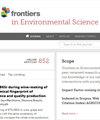Air pollution prediction using blind source separation with Greylag Goose Optimization algorithm
IF 3.3
3区 环境科学与生态学
Q2 ENVIRONMENTAL SCIENCES
引用次数: 0
Abstract
Particularly, environmental pollution, such as air pollution, is still a significant issue of concern all over the world and thus requires the identification of good models for prediction to enable management. Blind Source Separation (BSS), Copula functions, and Long Short-Term Memory (LSTM) network integrated with the Greylag Goose Optimization (GGO) algorithm have been adopted in this research work to improve air pollution forecasting. The proposed model involves preprocessed data from the urban air quality monitoring dataset containing complete environmental and pollutant data. The application of Noise Reduction and Isolation techniques involves the use of methods such as Blind Source Separation (BSS). Using copula functions affords an even better estimate of the dependence structure between the variables. Both the BSS and Copula parameters are then estimated using GGO, which notably enhances the performance of these parameters. Finally, the air pollution levels are forecasted using a time series employing LSTM networks optimized by GGO. The results reveal that GGO-LSTM optimization exhibits the lowest mean squared error (MSE) compared to other optimization methods of the proposed model. The results underscore that certain aspects, such as noise reduction, dependence modeling and optimization of parameters, provide much insight into air quality. Hence, this integrated framework enables a proper approach to monitoring the environment by offering planners and policymakers information to help in articulating efficient environment air quality management strategies.利用灰雁优化算法盲源分离进行空气污染预测
特别是环境污染,如空气污染,仍然是全世界关注的重要问题,因此需要确定良好的预测模型,以便进行管理。本研究工作采用了盲源分离(BSS)、Copula 函数、长短期记忆(LSTM)网络与灰雁优化(GGO)算法相结合的方法来改进空气污染预测。所提议的模型采用了城市空气质量监测数据集的预处理数据,其中包含完整的环境和污染物数据。降噪和隔离技术的应用涉及盲源分离(BSS)等方法的使用。使用 copula 函数可以更好地估计变量之间的依赖结构。然后使用 GGO 对 BSS 和 Copula 参数进行估算,从而显著提高这些参数的性能。最后,使用经 GGO 优化的 LSTM 网络时间序列预测空气污染水平。结果显示,与其他优化方法相比,GGO-LSTM 优化方法的均方误差(MSE)最小。结果表明,某些方面,如降噪、依赖性建模和参数优化,可以为空气质量提供更多的洞察力。因此,这一综合框架为规划者和决策者提供了信息,有助于制定高效的环境空气质量管理策略,从而使环境监测成为一种正确的方法。
本文章由计算机程序翻译,如有差异,请以英文原文为准。
求助全文
约1分钟内获得全文
求助全文
来源期刊

Frontiers in Environmental Science
Environmental Science-General Environmental Science
CiteScore
4.50
自引率
8.70%
发文量
2276
审稿时长
12 weeks
期刊介绍:
Our natural world is experiencing a state of rapid change unprecedented in the presence of humans. The changes affect virtually all physical, chemical and biological systems on Earth. The interaction of these systems leads to tipping points, feedbacks and amplification of effects. In virtually all cases, the causes of environmental change can be traced to human activity through either direct interventions as a consequence of pollution, or through global warming from greenhouse case emissions. Well-formulated and internationally-relevant policies to mitigate the change, or adapt to the consequences, that will ensure our ability to thrive in the coming decades are badly needed. Without proper understanding of the processes involved, and deep understanding of the likely impacts of bad decisions or inaction, the security of food, water and energy is a risk. Left unchecked shortages of these basic commodities will lead to migration, global geopolitical tension and conflict. This represents the major challenge of our time. We are the first generation to appreciate the problem and we will be judged in future by our ability to determine and take the action necessary. Appropriate knowledge of the condition of our natural world, appreciation of the changes occurring, and predictions of how the future will develop are requisite to the definition and implementation of solutions.
Frontiers in Environmental Science publishes research at the cutting edge of knowledge of our natural world and its various intersections with society. It bridges between the identification and measurement of change, comprehension of the processes responsible, and the measures needed to reduce their impact. Its aim is to assist the formulation of policies, by offering sound scientific evidence on environmental science, that will lead to a more inhabitable and sustainable world for the generations to come.
 求助内容:
求助内容: 应助结果提醒方式:
应助结果提醒方式:


